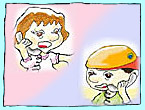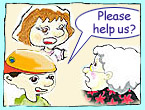Communicative functions: Interacting with others
| Asking people to do things |
Introduction
When we interact with others, we exchange two kinds of things:

|
We ask for and give information.
|

|
We ask people to do things for us and we
offer to do things for other people.
|
We can ask people to do two kinds of things:
give us something
|
|
do
something
for us
|
When we ask people to do things, we use a Command or a Request. A Command can be like an order, very direct and abrupt.
![]()

Come here at once!
Usually we ask people to do things in a more polite way by making a Request.
There are different ways to make and respond to a Requests. For example we can comply with the request and carry out the
action:
 |
Please help us! |
Requests |
|
Yes of course. |
complying with a Request |
We can also refuse the request:
Sorry, I can't help you at the moment.
I'm afraid I don't know how to help.
No, I can't just now. Maybe later.refusing a Request
For more information about asking people to do things, see:
![]() Text
types: Texts for social interaction: Overview: Keeping the interaction going
Text
types: Texts for social interaction: Overview: Keeping the interaction going
![]() Text
types: Texts for social interaction: Shopping
Text
types: Texts for social interaction: Shopping
![]() Grammar: Clause: Using clauses to interact: Making
Commands
Grammar: Clause: Using clauses to interact: Making
Commands
|
Tell me more ...
Making requests |
|
||
To give us feedback about this section, click here or on the Comment button at the top of the screen.
If you have any questions about this section, visit the Language Corner.
If you have any questions or suggestions about how to teach this section, send a message to the Teaching Corner.